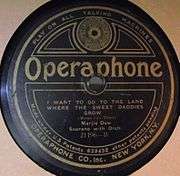Operaphone Records
| Operaphone Records | |
|---|---|
 | |
| Founded | 1915 |
| Status | Defunct |
| Genre | Pop, light classics |
| Location | New York City |
Operaphone Records was a record company in existence from 1915 until 1921, who released numerous phonograph records cut in the hill-and-dale and universal-cut methods.
History
The Operaphone Manufacturing Corporation of New York was established by John Fletcher, a professional musician and amateur inventor, in 1914 with George Thomas serving as company president.[1][2] A pressing plant in Long Island City was soon established.[2] Fletcher claimed in a trademark application that he had first used the name Operaphone beginning in March, 1915.[2] Advertising for Operaphone discs first occurred in January 1916, offering 8-inch discs for 35 cents.[1] 12 new discs (24 titles) were released each month.[1] Operaphone claimed their output of discs tripled between January and August 1916.[2] The price of the 10-inch records had been increased to $1.00 by July 1920.[1] The company was reorganized in 1918 as the Operaphone Co., Inc. Eight-inch records were discontinued, some 200 having been produced, and a standard-size 10-inch series of discs was announced, but the records remained vertically cut.[2] This series also failed to capture the public’s imagination (and wallets), and a final series of 10-inch records was introduced in July 1919. These discs used Emerson’s universal-cut system, which were intended to be playable phonographs using either the vertical or lateral reproducers.[2] These met with the most success, as they are the most commonly-found Operaphone products.[2] In March 1921 it was announced in the trade publication Talking Machine World that Operaphone would quit the record business.[1] The company was purchased by the Remington Phonograph Company, and it was reorganized as the Olympic Disc Record Company.[1] Subsequently, Harry Pace partnered with Fletcher to bring use of the Operaphone pressing facility to the new Black Swan Records.[3]
Operaphone also pressed records for client labels, including All-Star, Crescent, Domestic, and Elginola.[2]
In Canada, the discs were sold for CAN$0.50, distributed by Canadian Phonograph Company of Toronto.[2]
Format

Most Operaphone discs are vertically cut, but there is not consistency regarding the groove types of these discs. Some use the narrow-cut process similar to Edison Diamond Discs, while others use the sapphire-ball cut of Pathé Records[4] which is to be expected as some of Operaphone's masters originated from that company.[5] The very earliest Operaphone discs were 7 inches in diameter, vertically cut, with a paint-filled, etched label.[2] This was a very shortly-lived series, as an 8-inch series of vertically-cut discs quickly introduced.[2] It was claimed that these played as long as a twelve-inch discs.[1] The painted label was replaced by an etched, frosted label similar in appearance to the Edison Diamond Disc, but this labeling format was replaced in August 1916 by a standard paper label.[2] Ten-inch, vertically cut discs were released beginning in July 1918, and then a switch was made in July 1919 to the universal-cut format.[2]
Genre
Operaphone issued popular material of the day, including sentimental ballads, comic songs, and various instrumental selections, fitting with the motto “Music for Everybody” which appeared on the labels. A few items of moderate jazz interest by the Joseph Samuels outfit, under pseudonym, appear on Operaphone.[4] Fletcher claimed in 1918 that he planned to release “the entire symphonic repertoire”, but nothing ever became of these plans.[2] Despite the label’s name, no serious operatic recordings were released on Operaphone.[1] Operaphone attempted to increase record sales by placing highly disparate material on the opposite side of their records. The strategy backfired, and Operaphone ceased the practice within a few months.[2]
All material was leased from Pathé, but there are known instances where material appeared on Operaphone as early as a month before the recording was issued on Pathé itself. There was no public acknowledgement of a tie between the two companies.[2]
Selected artists
- Sam Ash[6]
- Al Bernard[1]
- Collins & Harlan[7]
- Arthur Collins[8]
- Frank Ferera[9]
- Ernest Hare[1]
- Charles W. Harrison[7]
- Billy Jones[1]
- Lewis James[1]
- Billy Murray[1]
- Dan W. Quinn[7]
- Aileen Stanley[10]
References
- 1 2 3 4 5 6 7 8 9 10 11 12 13 Andrews, Frank (2005). Hoffman, Frank, ed. Encyclopedia of Recorded Sound. Routledge. pp. 777–778. ISBN 0-415-93835-X.
- 1 2 3 4 5 6 7 8 9 10 11 12 13 14 15 16 Sutton, Allan (2000). American Record Labels and Companies – An Encyclopedia (1891–1943). Mainspring Press. pp. 151–153. ISBN 0-9671819-0-9.
- ↑ Thygesen, Helge; Berresford, Mark; Shor, Russ (1996). Black Swan: The Record Label of the Harlem Renaissance: a History and Catalogue Listing Including Olympic Records and Associated Labels. VJM. p. 89.
- 1 2 Rust, Brian (1984). The American Record Label Book. New York: Da Capo Press. p. 219. ISBN 0-306-76211-0.
- ↑ Berresford, Mark (2010). That's Got 'Em!: The Life and Music of Wilbur C. Sweatman. University Press of Mississippi. p. 193. ISBN 9781604733716.
- ↑ Gracyk, Tim (2000). Popular American Recording Pioneers 1895–1925. New York: The Haworth Press. p. 33. ISBN 1-56024-993-5.
- 1 2 3 "Record Bulletins for September, 1916". Talking Machine World: 100. September 1916. Retrieved January 5, 2016.
- ↑ "Record Bulletins for May, 1917". Talking Machine World: 126. May 1917. Retrieved January 5, 2016.
- ↑ "Record Bulletins for August". Talking Machine World: 126. July 15, 1918. Retrieved January 5, 2016.
- ↑ Cullen, Frank (2004). Vaudeville old & new: an encyclopedia of variety performances in America, Volume 1. Routledge. p. 1063. ISBN 9780415938532.